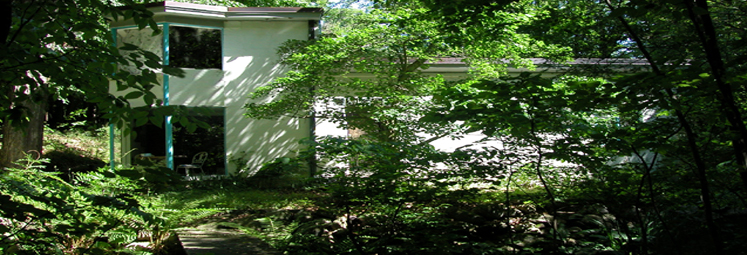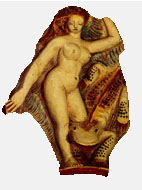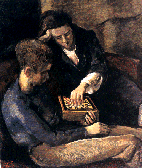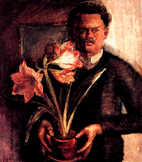|
|

|
|
"For
my part," wrote New, York Times art critic Edward Alden Jewell
in 1934, (I Will pit Henry Varnum Poor against any living artist."Ranked
in the forefront of the artists of his day, Henry Varnum Poor (1887-1970)
was a contemporary and peer of such painters as Thomas Hart Benton
(1889-I975), Charles Burchfield (1893-1967), Rockwell Kent (1882-1971),
Edward Hopper (1882-1967), Leon Kroll (1884-1974), and Reginald Marsh
(1898-1954)--a generation of representational painters who matured
artistically in the Depression era and who translated the European
modernist aesthetic into a truly American idiom. Alex Katz correctly singles out directness as Poor's most important gift as an artist. His contributions to American modernism were an insistence on simplicity of means, attention to craftsmanship and pictorial necessity, and a freedom from dogma. As Harry Salpeter wrote in a 1938 Esquire article, Poor "is Emerson's essay on self-reliance come down from Maine by way of Kansas." Born on the prairie in Chapman, Kansas, Poor grew up "loving every bit of the familiar earth and its even more familiar creatures." His initial impulse was to become a naturalist, but at Stanford he majored in art, graduating Phi Beta Kappa in 1910. That same year, Poor sailed to London where he studied with painter Waiter Sickert at the Slade School. Sickert provided Poor with rigorous instruction in drawing and with a philosophical commitment to directness and simplicity in art. "One of the delights of art," Sickert insisted, "is the joy off setting effects produced with an economy of means." In London, Poor also attended the landmark Grafton Gallery exhibition which brought Cezanne, Matisse, Picasso, Van Gogh, and Gauguin to the attention of the British the way the legendary Armory Show would bring the sea change of modernism to America three years later. Art was no longer about imitating nature, it was a matter of self-expression, making a personal statement in an increasingly impersonal world. Poor returned to teach at Stanford and became one of the leading modernist painters on the West Coast, but, in 1919, he headed back east, settling on a farm on South Mountain Road in New City, a small art colony in the New York's Hudson River Valley. There he designed not only his own home and studio, but also the homes of several other prominent local residents, among them playwright Maxwell Anderson, actor Burgess Meredith, actor-director John Houseman, and cartoonist Milton Caniff..When his first exhibition of paintings in New York City proved less than a commercial success, he deftly turned to ceramics to make a living. Inspired by Cretan pottery in the collection of the Metropolitan Museum of Art, Poor quickly mastered the art and craft of painted ceramics and spent roost of the Igzos earning a national reputation as a fine art potter. During the 1930s, Poor became one of America's foremost muralists, executing major fresco commissions for the U.S. Department of Justice and the U.S. Department of the Interior in Washington and for The Pennsylvania State College. Fresco, like pottery, demanded not only a high degree of craftsmanship but also a willingness to execute a design swiftly, directly and with finality. During World War II, Poor serc·ed as an Army artist in Alaska, where he met fellow painter Willard Cummings. In 1946, Poor and Cummings, along with painter Charles Cutler and sculptor Sidney Simon, founded the Skowhegan School of Painting gr Sculpture, a summer school for artists run by artists on Lake Wesserunsett in Maine. Just one of the legacies Henry Varnum Poor left is the fact that Skowhegan is one of the few art schools that still teaches the art of fresco. Harry Salpeter called Poor "the artisan in the artist," and it is, indeed, Poor's crafts~nanship that underlies the directness of his art. Whether scratching images into wet slip on a ceramic surface, mixing lime putty into his wet frescoes for permanence, or pushing wet oils across a canvas, Poor brought a sense of immediacy to his art. Everything his eye saw and his hand did is right there on the surface where it belongs. Working in a somber industrial palette of browns and grays inherited from the Ashcan School, Poor created a lifetime of pensive portraits and tigure paintings, brooding landscapes, and solid still-lifes in which vases, jugs and pitchers, fruit, fish and flowers sewed as surrogate vessels for the human presence and the social enterprise. Whatever the subject matter, however, Poor was always matter-of-fact and understated in his approach. "You can quietly say what you have to say in a less spectacular way," he said, "and by not saying so much perhaps say something more pointed." Henry Varnum Poor--direct and to the point. EDGAR ALLEN BEEM (Edgar Alien Beem is a freelance writer in Maine. He is the author of Maine Art Now, and the forthcoming Maine volume in the Harry Abrams Art of the States series.) |
||
 |
|||
 |
|||
